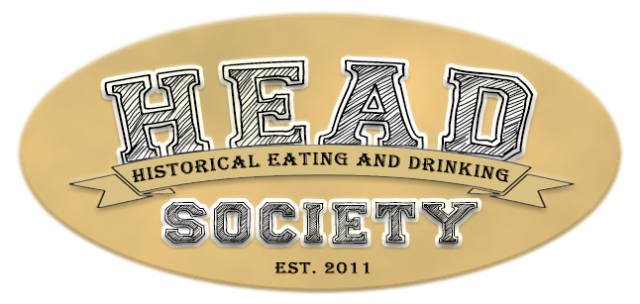
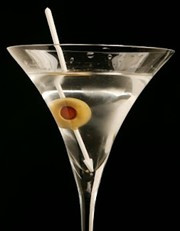
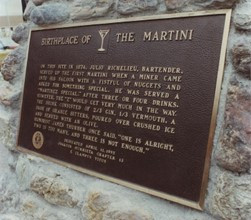
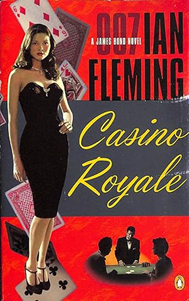
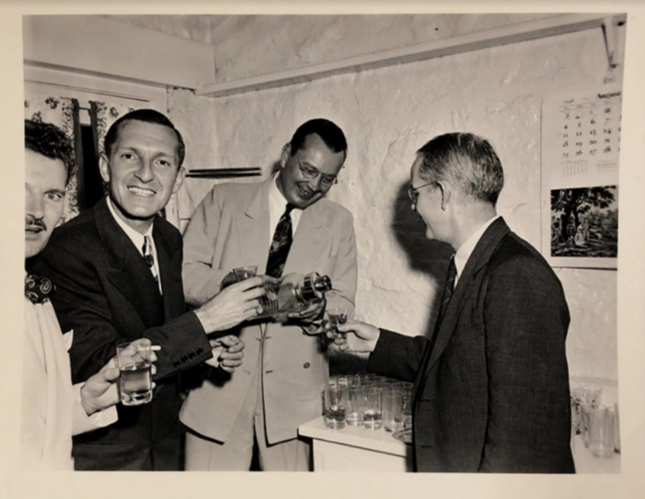
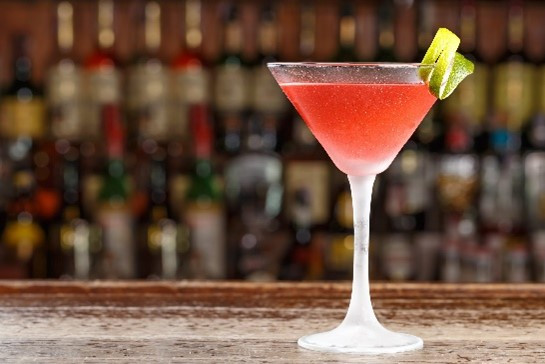
The Martini Story
The cocktail is an American creation. Many of these tasty concoctions have roots right here in the San Francisco Bay Area. The Pisco Punch, Mai Tai, and the Martini are all natives. Perhaps the most famous is the Martini. New York and San Francisco both claim to be the birthplace of this drink, but little Martinez is the rightful home to this cocktail classic.
There are many origin stories for the Martini. Some say the name comes from the Italian vermouth maker, Martini & Rossi. Others claim the name comes from a rifle used by the British army. The Martini-Henry rifle, like the cocktail, was said to have a “strong kick”. Colorful tales but not true. For that we must visit Martinez, California, a small town with a population of 560 in 1870.
Following the California gold rush (sometime between 1862 and 1874), a miner came into Julio Richelieu’s saloon in Martinez. To celebrate his newfound wealth, he ordered champagne. None was available but Julio offered him “something better” a “Martinez Special”.
There are two versions of the original recipe:
#1) 4-parts Old Tom Gin (which had a strong juniper flavor), 1-part sweet vermouth, 1-part bitters and cherry elixir.
#2) 2 parts gin, 1-part vermouth, a dash of orange bitters.
Whichever recipe the original followed, the customer loved the drink and ordered a round for the house!
Before long, the drink made its way across San Francisco Bay from sleepy Martinez to the bars of San Francisco. The recipe was published in O.H. Bryon’s 1884 Modern Bartender’s Guide. Three years later Professor Jerry Thomas published it in The Bon Vivant’s Companion: Or How to Mix Drinks. Thomas was America’s first celebrity bartender. He, of course, claimed credit for the drink during a visit to San Francisco.
It is said that the name changed from Martinez to Martini since the “z” was too hard to pronounce after drinking a few. Julio’s original saloon was at 414 Ferry St. at Marina Vista. For many years it was Amato’s restaurant. Today it is the Ginger Thai restaurant.
Even though the Martini has been around since the California Gold Rush. It began to gain popularity during Prohibition. In an era where “bathtub gin” was readily available, many speakeasies featured gin-based cocktails. Early recipes called for a simple drink; two parts gin, 1 part vermouth with no garnish. Prohibition’s gin joints boosted the cocktail to three parts gin and one part vermouth. At the same time, olives began to garnish the glass.
Martini Styles
Early martini recipes varied across the country. Some versions, including the original Martinez Special, were sweeter than the drink we know today. Some of the early versions contained a wide range of interesting ingredients including gum syrup, Caraçao or even Maraschino. The modern dry martini first appeared at the Knickerbocker Hotel in New York City in 1911 or 1912.
Most martini recipes fall into these categories:
- Dry Martini – less vermouth, often only enough to coat the inside of the glass.
- Dirty Martini – a splash of olive juice and several olives are added for a hint of brine.
- 50-50 – equal parts of gin and vermouth.
- Perfect Martini – a ½ ounce of both sweet and dry vermouth are added.
- Reverse Martini – use 3 ounces of vermouth and 1 ounce of gin. Often considered an apéritif.
- The Vesper – James Bond’s favorite.
- Vodka Martini – gin is replaced with vodka.
|
Classic Martini 3 oz Gin 1 oz Dry Vermouth Lemon twist or 1-3 pitted/stuffed olives or cocktail onions. |
By the 1940s and 1950s the Martini continued to grow both in popularity and in strength. Famous Martini lovers include President Franklin Roosevelt, Alfred Hitchcock and Humphry Bogart. FDR liked his Martinis strong, 7 parts gin to 1 part vermouth. Hitchcock wanted his Martini to “give a glance at the vermouth from across the room.
The Vesper
The Vesper Martini appeared in Ian Flemming’s Casino Royale, the first James Bond story, published in 1953.
In Chapter 7, “James asks a bartender, “A dry martini”, he said, “in a deep champagne goblet”.
“Oui monsieur”
“Just a moment, three measures of Gordon’s gin, one of vodka, half a measure of Kina Lillet. Shake it very well until it’s ice cold, then add a large thin slice of lemon peel.”
James Bond first says, “shaken and not stirred” in the 1958 book, Dr. No. The phrase made it to the big screen in the 1964 movie, “Goldfinger”. It was the third Bond movie.
|
The Vesper: James Bond’s Martini 3 oz London Dry Gin 1 oz Vodka ½ oz Lillet (Dry Vermouth) Garnish with lemon peel. |
The Oppenheimer Martini
During the 1940s, the Martini was a cultural icon, for many the cocktail of choice. J. Robert Oppenheimer (Oppie) was not only the father of the atomic bomb, but a well-known mixologist.
At Los Alamos, Oppenheimer regularly hosted parties for his fellow scientists and their wives. Because vermouth was hard to get at Los Alamos, Oppie created his own recipe. Oppenheimer serving cocktails.
As listed on the webpage for the Los Alamos National Laboratory: “Four ounces of gin and a dash of vermouth; the rim of the chilled glass was dipped in honey and lime juice.”
Pat Sherr, wife of a lab physicist, said, “He [Oppenheimer] served the most delicious and coldest martinis.”
A visiting scientist commented that, “The high alcohol made it hard to get up from the dinner table, let alone walk home.”
|
The Oppie Martini 4 oz dry London gin ¼ oz Vermouth Shake over ice until very cold. Strain into a cold glass – rim dipped In honey and lemon juice (50/50 mixture). |
The Dirty Martini
This popular version goes back to 1901 at New York’s Waldorf Astoria Hotel. It was there that bartender John O. O’Connor created the cocktail by muddling olives and adding them to the shaker. The olives bits were strained out, but the hint of olive brine remained.
The first published reference to the Dirty Martini appeared in G.H. Steele’s My New Cocktail Book published in 1930. Steele’s recipe called for the addition of a teaspoon of olive brine. This version is commonly made with either gin or vodka. Vodka may be a better match for the olive brine.
|
The Dirty Martini 1 ¾ oz London Dry Gin or Vodka ¼ oz Dry Vermouth ¼ oz Olive Brine Garnish with 1-3 green olives |
The Cosmopolitan – The Pink Martini
The Cosmopolitan or Cosmo is a cocktail that evolved over time. In 1927, during Prohibition’s heyday, the name was first used to describe a Scotch whiskey drink.
Its real roots go back to another Prohibition Era cocktail, the Daisy. The Daisy was a combination of gin, Cointreau, lime juice, and raspberry syrup.
In the1960s, Ocean Spray cranberry juice promoted a vodka and cranberry juice drink they called the Harpoon. The recipe was published on their bottles. Home cocktail parties were very popular, and Ocean Spray wanted to get in on the action. The Harpoon was gin, Roses’s lime, cranberry juice and Triple Sec.
In the 1970s, gay bars in Provincetown, Massachusetts began adding cranberry juice to the Kamikaze cocktail (vodka, Triple Sec and lime juice). The drink spread to San Francisco.
|
The Cosmopolitan 1 oz vodka ½ oz Triple Sec ½ oz lime juice 1 oz cranberry juice |
Several bartenders are credited with inventing the Cosmo:
- 1975 - Neal Murry in Minneapolis.
- 1985 - Cheryl Cook in Maimi and Toby Cecchin in New York City.
The drink became very popular in San Francisco’s gay community. It was first served in San Francisco at Julie’s Supper Club (1123 Folsom St.).
In 1988, New York bartender Tony Cecchini was visiting San Francisco when he tasted his first Cosmopolitan. Upon his return to New York City, he reinvented the drink. Tony made it less sweet and replaced Roses’ lime juice with fresh lime juice – a big improvement.
The cocktail hit its peak with 1998’s “Sex and the City”.
May 7th is National Cosmopolitan Day.